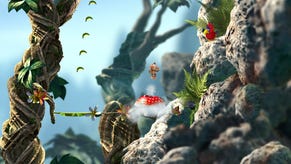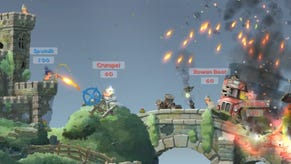Hands On: Worms - Clan Wars
Clan you believe it?
Last week, I visited Team 17 and was the first outsider to have hands-on experience with their latest game. It’s a Worms game because, on the whole, that’s what they do. Unlike the previous release, Clan Wars has been designed specifically for PC and while it’s the multiplayer league system that worms its way into the title, the additions and tweaks to the physics system may be the necessary game changer.
How do you solve a problem like Worms? First of all, you work out what the problem is. No, scratch that. First you have to admit that you have a problem.
It’s odd to think of a franchise that has helped an independent developer to survive two decades of changes in the gaming industry as a problem but the inevitable arrival of another entry in the series will certainly cause eyes to roll. Team 17 are among the last of the once-thriving North West development scene, which once included Ocean, the license factory. The bulky boxed copies of Amiga games in their offices are a strange reminder of how much has changed over the years. Now, I can download a Worms game onto my phone, summoning it from the air as I sit on a couch waiting to speak to the development team.
How is this a problem? Perhaps it's a rut, like a regularly released sports franchise that struggles to improve or to offer anything new. Worms has adapted to the new ways of being, but it has always been at its best when closest to its original formula. Armageddon remains the peak as far as I’m concerned – packed with weapons and customisation options. It’s also well illustrated, cartoonish and colourful, yet clean and legible.
Personally, whenever I see one of those old cardboard boxes, I think of Psygnosis, who were based in Liverpool, not a great distance from Team 17’s current home. The artwork that clothed games such as Blood Money and Shadow of the Beast was more striking and imaginative than many games, either then or today. They were my equivalent of the Diamond Dogs and King Crimson vinyl sleeves that my parents always shuffled to the front of the stack, begging and daring the observer to judge by the cover, just this once.
I knew very little about the new Worms game before arriving at the studio but by digging through the entrails of an invertebrate, I was able to make some bold predictions. There would be worms and they would kill each other. I had a name – Worms: Clan Wars – and a basic fact sheet that confirmed what the title suggested: there would be social features and lots of them. If all the team had to show was Worms: Revolution with some sort of Facebook attached to it, the visit would have been short and underwhelming, but after taking the criticism of the previous game on board, particularly from the PC community (that’s you!), changes have been made.
Clan Wars is the Janus of the Worms franchise, using modern physics tech and the powers of connectivity to enhance and expand on the decades-old formula, while looking back to its own beginnings. But, of course, every Worms game looks backwards and even the misjudged leap to 3d was a variation on the wheel rather than a reinvention of it. This time, much of the development team is made up of new blood, so rather than making yet another Worms game, they’re being tasked with creating what is, for some, their first Worms game.
But how much has changed? Worms is, as ever, a comic take on the strategic artillery genre, with the increased mobility and defensive capabilities that have become a staple of the series. There are traps and turrets to drop in the landscape, and a suite of tools for base construction. And then there are the weapons.
Concrete donkeys, super sheep and holy hand grenades all return, and there are additions, most of which relate to the new qualities present on the randomly generated landscapes. Flying monkeys can pick up physics objects, which are scattered around the maps, dropping them elsewhere. Unlike the terrain itself, these items roll, bounce and tumble, squashing worms as they go, and often containing poison or explosives. Then there are the fluid physics, introduced in Revolution but much improved here.
Worms drown when they contact the sea that lies at the bottom of every screen, but the water within the level isn't quite as straightforward. It runs downhill, drips off overhangs and carries worms with it as it flows. Any combatant ending a turn underwater loses health and mobility is reduced while wading, but it’s the weapons that take advantage of fluids that make the tech most worthwhile. Water pistols are more like hosepipes, knocking targets backwards and creating pools and rivers, while the aqua jet seems destined to become a favourite. It’s a jetpack that spews gouts of water whenever the boost is activated, drenching and confusing everyone below.
Playing a multiplayer session against the people who made a game can be a sobering experience. The way things were going last week, as we settled into a series of 2 vs 2 matches, I think an actual worm could have beaten me by writhing around on the keys. My team mate was a smart player, the sort who can traverse an entire map using a ninja rope and a teleport gun, zipping from valley to peak, and dropping explosives directly on the heads of his enemies as he went.
I was more interested in staying alive, collecting medikits and lobbing the occasional grenade off the edge of the map.
The class system from Revolution returns but, like everything else, it has been tweaked. There are four types of worm, each easily spotted thanks to exaggerated proportions. There are a great deal of customisation options, some unlocked by playing through the single player campaign, but classes on every team share the same physique. Scientists are the bulbous-brained healers. Heavies are large but slow, the Brock Lesnars of the annelid world. Then there are the skinny scouts, potentially the most dangerous in the hands of an experienced player. They have increased mobility and the tunnels that they dig are longer and narrower – no other class can squeeze down them, so a team of scouts can hide deep in the earth. The basic soldier class can detonate any timed device, including banana bombs and grenades, at will, even if the fuse hasn’t burnt down.
By making the distinctions between classes more exaggerated, the aim is to provide more room for different strategic approaches. The Clan Wars of Clan Wars are where the game takes itself more seriously, although it’s still as daft as a cat in trousers. The clan system does provide the possibility for dedicated competitive play though, with league play, timed seasons, promotions for teams and individual members, and all sorts of clever matchmaking.
The creator of a clan becomes the leader, creating a logo and name, and choosing whether membership will be open to all, or only to friends or those invited. A level one clan can have up to eight members, although only two can fight together at any one time, while a top level clan can have 120 members. Every time a clan member fights, their result feeds back into the system and at the end of the season, movement between divisions is decided. As well as setting basic rules, clan leaders can bestow officer rank on other members, giving them the same rights, including the ability to send out newsletters and calls to arms.
It’s a elaborate system, with a companion app for cleverphones that tracks more stats than the US government. There’s a singleplayer mode as well, set in a museum from whence the landscape themes are drawn, from the prehistoric to the industrial. The levels are a mixture of platform-puzzles and more traditional deathmatches, and they utilise complex Little Big Planet-esque physics contraptions, which can also be added to custom levels in multiplayer. The story is as silly and British as expected, with a Lara Croft spoofing voiceover provided by Katherine Parkinson of the IT Crowd and them there Maltesers adverts. With Matt Berry having provided vocal duties on the previous game, I raised the possibility of Chris Morris being approached for the next, but everyone looked a bit worried. I maintain that Worms: Jam is the way forward.
It’s been a while since I played a Worms game and as I blundered through, I was reminded of a conversation I had with Johan Pilestedt of Arrowhead, creators of Magicka and The Showdown Effect. We’d discussed Magicka’s genre, not as an action RPG or multiplayer monsterslaughter simulator, but as a tool for improvised comedy. Watching my heavy worm pathetically attempting to flee from a stick of dynamite, slower than an actual worm stranded on a highway during the fourth day of a heatwave, I realised that Worms is essentially the same thing. The unexpected bounce of a banana that takes out an entire team, friendly or otherwise, or the mine that you didn’t spot, right in the middle of the landing strip your jetpack was aimed at. If it turns out to be a dud, hissing and letting out a gasp of smoke, all the better.
Artillery games have appealed to me since I found Scorched Earth so many years ago and spent a summer attempting to convince everyone I knew to play it instead of Doom. But this is Worms. Again. The improved physics do increase the potential for the unexpected, particularly the chaos of flowing fluids, and every turn is more likely to contain a moment of slapstick. While there will be those who master the movement of their units and the weight of each weapon, investing time and effort into the clan system in an attempt to rise through the divisions, I’ll probably continue to kill myself and my team mates, or to burrow far beneath the surface and construct ludicrous bases.
In fact, the more I think about it, the more I realise it’s all about the prod. Or mostly about the prod. That most satisfying of finishing moves, a poke in the chest that can send a precariously balanced enemy tumbling toward death. Dislodging a boulder and watching it roll down hill or lobbing a water bomb that washes people in to a valley – these are new and pleasing ways to dispatch a friend or foe. Clan Wars isn’t doing anything particularly new but it’s doing it all as well as it can be done and, for the first time in ages, with a game designed specifically for PC, including Steam Workshop integration and an interface that actually knows what a mouse and keyboard are.
Worms: Clan Wars will be making an appearance at Rezzed this weekend, as will I, occasionally testing my own knowledge of fluid physics in a nearby bar.






















